Grant's Gear Pages
Page 3: Software and DAWs
Datel Digital Sound Sampler for Sinclair Spectrum 48K
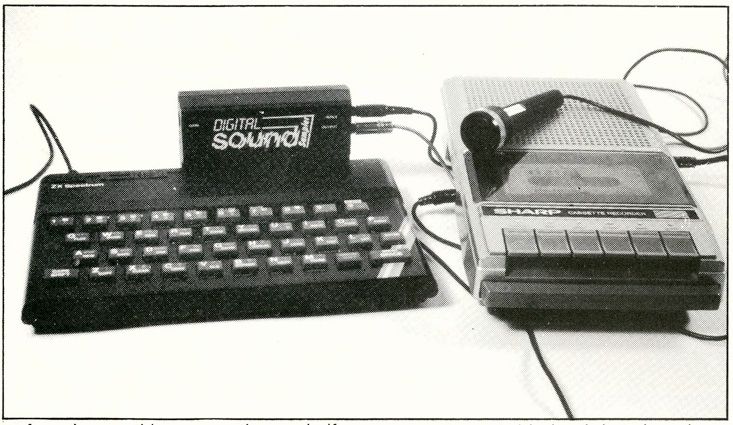
I bought the Datel Sound Sampler for the Spectrum via mail-order, after reading a
review in the April 1985
issue of Electronics & Music Maker magazine. This was at a time when sampling was still a mystical
technology available only on high-end instruments like the Fairlight and Synclavier. After
plugging it into the back of my Spectrum and loading the software from cassette, I was able
to record and play back all sorts of sounds in glorious 8-bit resolution. The supplied software
consisted of various utilities such as echo (with a hardware feedback level preset pot,
accessible with a small screwdriver). There was also a musical keyboard which allowed you
to play back samples at different pitches.
Things really got interesting when I got down to writing my own software to drive the hardware,
though. Basically, the hardware consisted of an Analogue to Digital Converter (ADC) and a Digital
to Analogue Converter (DAC), with the necessary circuitry to provide an anti-aliasing filter on
the input and a reconstruction filter on the output, as well as input gain and feedback.
Recording audio consisted of reading the ADC in a tight loop and storing the values in RAM.
Playback consisted of reading the values in RAM and sending them to the DAC in a tight loop.
Different playback pitches could be achieved by altering the time between outputting values
to the DAC, or by taking different step sizes when reading through the sample data in RAM.
My first project was to create a pitch shifter. I read values from the ADC into a table in RAM.
If memory serves (no pun intended), I made the table 256 bytes in length so that I could perform
"fixed point" maths using two 8-bit registers as an integer:fraction pair. If you set the
replay increment value to 256, this would step through the sample values at exactly the same
rate as which they were being written. Setting the increment value to 512 would mean that you
would replay the sample values at twice the rate at which they were being written; this would
create an upwards pitch shift of one octave. Of course, this would mean that you would quickly
run out of values to read. The table could be considered a circular loop of tape, with the
record head running round at a fixed rate, and the replay head running faster (for an upward
shift) or slower (for a downward shift). Eventually, the two heads will pass each other, which
could lead to a discontinuity in the output waveform, causing a click or glitch, depending
on the input waveform. Anyhow, the system worked remarkably well, allowing you to create
real-time chipmunk and demon voices. Applying a bit of hardware feedback led to upward or
downward spirals of sound. Admittedly, due to the 8-bit resolution, noise would eventually
swamp any desired sound.
My next project was more involved. It was a Phase Distortion Wavetable Synthesizer. Like
the pitch shifter, I built up a series of wavetables, each one 256 bytes in length, so that
I could use the same integer:fraction increment value for choosing the playback pitches of
two 'virtual oscillators'. The contents of each wavetable were calculated offline to allow
the creation of dynamic timbre and amplitude envelopes. Like the Casio CZ-101, there were
a limited selection of phase distortion wave pairs (carrier and modulator). Off the top of
my head, there were two or three FM sine pairs, sine to square and sine to sawtooth
transforms, some hard sync sounds and some 'phase offset' waves which allowed you to perform
vibrato by quickly varying the starting phase of each oscillator. A musical keyboard was
laid out on the 40-key QWERTY Spectrum keyboard. I was so pleased with the program that
I sent it off on a tape to Datel with a view to them supplying it with the sampler. I
heard nothing back. :(
Next up was a multi-timbral drum machine. I wrote this with a view to actually using it
for recording or jamming, and not just as an intellectual exercise. I calculated that
it would be possible to add the output of three virtual playback channels together
within the time allowed for one sample replay period. I created an editor which was
a little bit like the Fairlight Page R sequencer, with a grid of 16 beats on the X
axis, and three channels on the Y axis. Each grid location could contain a sample
number (1 to 8) or a rest. To create accents, you could place the same sample number
on two or three of the channels at the same beat location. The editor allowed you to
build up several "bars" in memory and then chain them together into a "song". It was
surprisingly useful as a drum machine, and could even be used as a poor man's
Fairlight if you chose suitable samples as your source. In many ways, it was quite
similar to the hugely successful
Cheetah Specdrum,
with the important
distinction that you could sample your own drum kits (or any sample set, for that
matter).
d-lusion RubberDuck TB-303 simulator
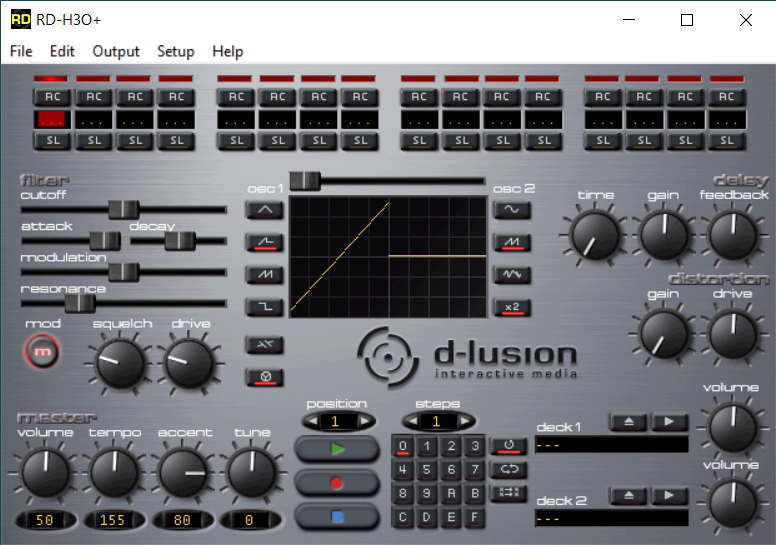
I downloaded a shareware demo of this when I was at DMA in 1996. A few of us clubbed
together to buy a license for the full version. I think it was the first genuine
virtual analogue softsynth I'd heard which really lived up to the promise. You can
download it for free
these days from the
d-lusion website (along with
many other interesting applications).
Propellerheads Rebirth RB-338 TB-303 / TR-808 simulator
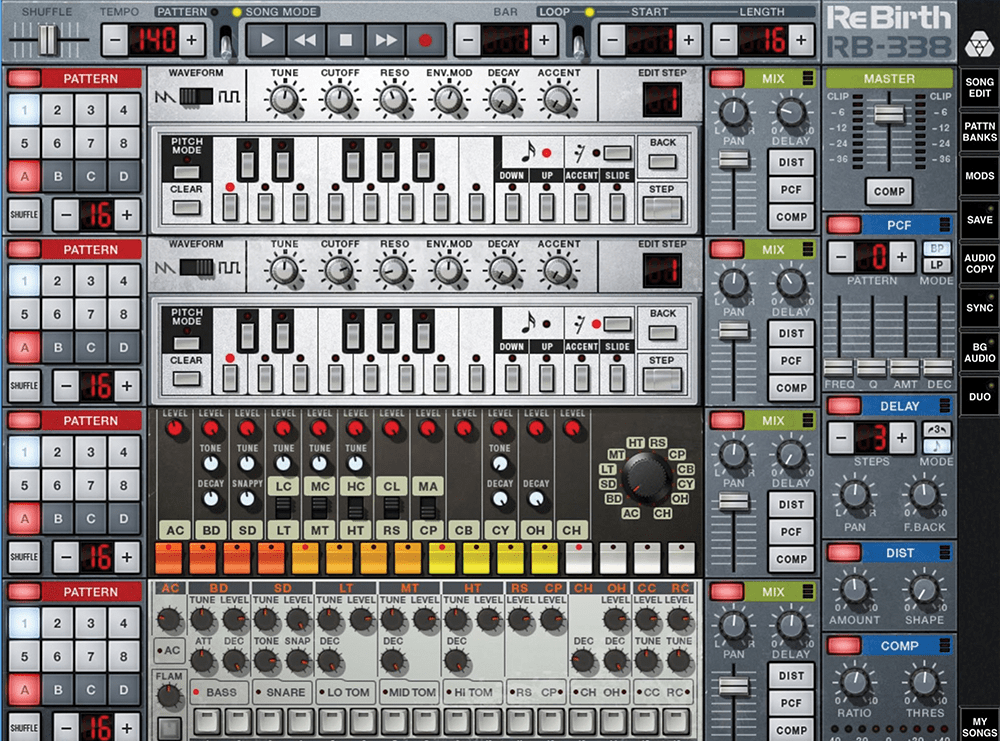
I was gobsmacked by Rebirth when it was released in 1996. I guess that both the
original TB-303 and TR-808 were starting to achieve iconic (and overpriced) status
by that point in time. To hear them replicated so closely in software, and to be able
to run it on mid-'90s PC hardware, was an outstanding achievement. Propellerheads
(now Reason Studios) went on
to develop the very first version of Reason in 2000,
and it was similarly able to run efficiently on fairly modest equipment.
n-Track Studio
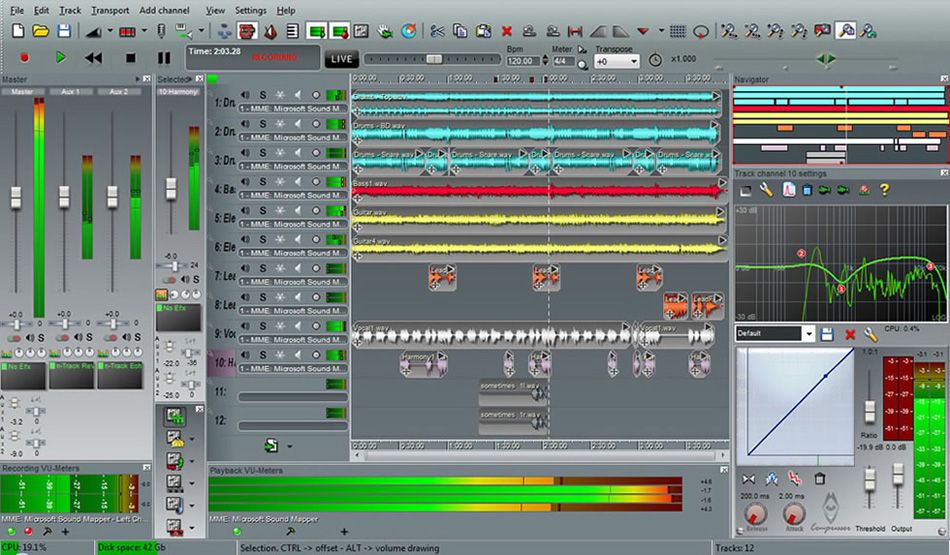
Since using the Pro-Tools III setup at DMA Design, I had always dreamed of being able
to run it (or something similar) at home. That "something similar" appeared in the form
of n-Track Studio for Windows. It was available to download in a demo form, with
restrictions on the number of tracks you could use, and what effect plug-ins you
could apply. It was a good marketing strategy, as it let me test out its usefulness
for my purposes. After a few days use, Colin bought a full license for it, and it
became the Under the Dome studio software for a few years. In fact, Bellerophon
was mixed in n-Track Studio, and the track 'Return' was completely 'moused' into the
piano-roll MIDI editor, without a single note being played on a musical keyboard.
n-Track Studio had most of the features of Pro-Tools, such as mixdown automation,
DSP plug-ins for effects and softsynths, and a non-linear recording paradigm. My
single gripe with it was that it would often lock up completely when you were setting
automation points on audio tracks. I had to get into the habit of saving tracks
before attempting automation editing. Apart from that, it was a fantastic system,
which supported Direct-X and VST plug-ins, and VSTi synths. I even upgraded to the
24-bit version when I bought the M-Box, preferring it to the Pro-Tools LE software
which came bundled with the hardware.
Pro-Tools LE
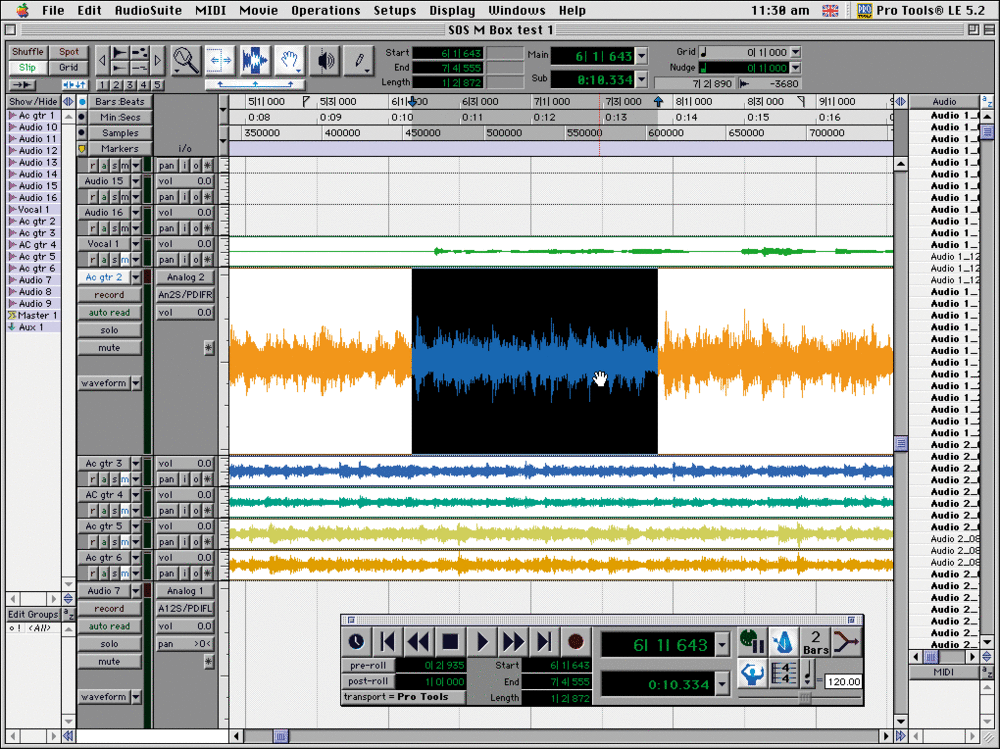
After Colin left DMA, he bought himself a full PT-III system second-hand and it
still resides at Dome Studios North (though sadly dormant for many years). When I bought
my M-Box audio interface in 2005, it came bundled with Pro-Tools LE, which worked
completely in software. The demo song that came with it really showed off how powerful
a system it could be. The more powerful your processor and the more memory and disk
space you had available, would allow it to expand the number of tracks available and
the number of effects plug-ins you could run. Sadly, I never really had the time to
fully explore recording music on this system. I was bitterly disappointed that I
couldn't use the M-Box on Windows after the introduction of Vista / Windows 7. I
ended up giving it to my nephew Craig, along with a second-hand Windows XP machine.
Propellerheads Reason Adapted
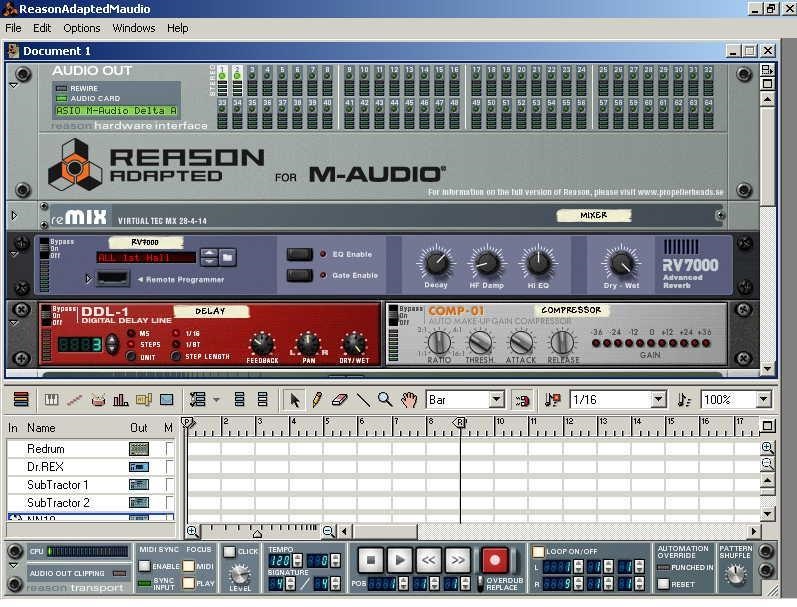
As well as Pro-Tools LE, the M-Box came bundled with "Adapted" versions of Ableton
Live and Propellerhead Reason. I must admit that I never really formed much of a
relationship with Ableton, but Reason was right up my street. If memory serves,
you had a fixed rack with two instances of SubTractor, one of the NN-19 sampler
and one of Redrum. It was limited in many ways; for example, a patch that you
constructed for NN-19 was tied to the song you created, and could not be stored
off as a separate disk file. As you can imagine, building up a multi-sample patch
such as Mellotron Choir was a lot of work to have to replicate every time you
created a new song. However, once again, it was a great marketing ploy on the
part of Propellerheads (now simply Reason Studios), to give out a restricted
copy of the full suite free of charge. From that point on, I was very interested
in getting a full copy of Reason, especially after hearing what Colin could achieve
with it for the UtD track "Philadelphia Experiment".
Propellerheads Reason 4.0
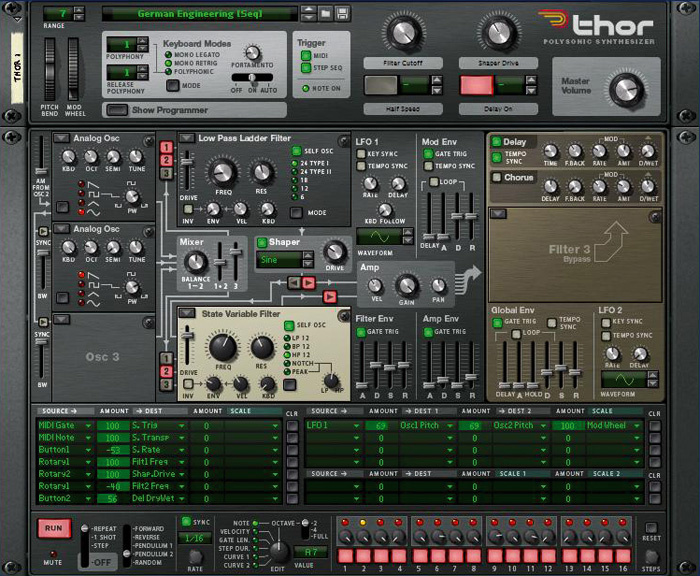
Back in the day when Reason was still a self-contained real-time MIDI-driven
software studio, it was possible to download, ahem, "Evaluation Copies" (AKA
cracked software) from your friendly local neighbourhood torrent tracker. I
found a version of Reason 4.0 with a bundled key generator and so had access
to the full version of it (complete with Orkester sample disk). I have to say
that I was blown away by the quality of many of the instruments and effects
available, and just how efficient it all was in terms of CPU load. I never
actually used the recording and mixing side of things to any great extent,
and ended up using it mostly as a real-time softsynth played from a remote
MIDI keyboard (Alesis QX49, which I still use to this day).
I created many
multi-sampled soundsets for NN-19, particularly Mellotron tapesets from Klaus
Hoffmann-Hooke's archive CDs. I've never been a fan of sampling as a
synthesis method, with two notable exceptions: sampling individual percussion
sounds for a drum machine, and multi-sampling over the entire range of an
instrument. As a result, I really had to wait years for
it to become possible for a home recording hobbyist to be able to throw huge
amounts of memory at a multi-sampled sound.
The other module I found to be incredible was the
Thor Polysonic Synthesizer. You can create patches using pretty much every
synthesis technique available from the analogue sounds of the '70s, through
to PPG wavetable techniques, FM synthesis, Phase Distortion, etc. To this day,
Thor is my go-to synth for pretty much anything, except those few occasions
where I require very special machine-specific quirks, such as the MiniMoog
filter or its envelope response. The main drawbacks with Reason were the lack
of audio tracks and the inability to add third-party VSTs to the rack.
These two factors could be mitigated to a certain extent by running nTrack Studio
in sync through Re:Wire, but it was such a complete faff that it drained
you of any creative impulses before you even got started.
Arturia V-Collection Classics
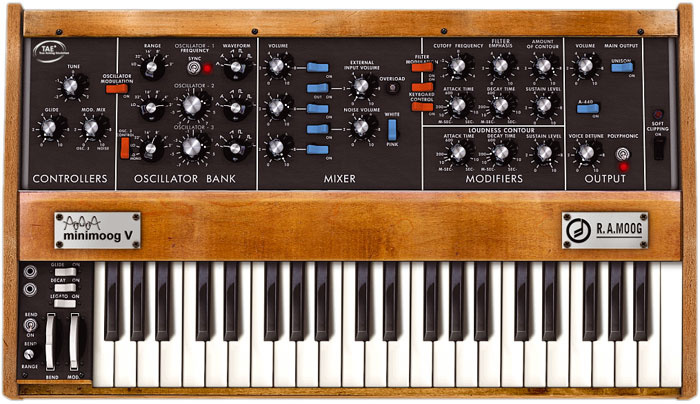
Of all the genuine vintage synths I had always dreamed of owning, the MiniMoog
would have to come in at Number 1. There's something so electric about its sound,
and it has been responsible for so many of the synth sounds that blew me away
when I was growing up. Sadly, the chances of me actually being able to own a
genuine one seemed very remote, even during the late '80s, when I got into synth
collecting in a big way.
The Steinberg Model-E softsynth showed that it was
possible to create MiniMoog-ish sounds purely in software, and that there was
nothing inherently 'magical' about the analogue hardware. However, as soon as I
had a play about with the Arturia Mini V demo, I knew that someone had got about
close to the real thing as possible - or at least something which did everything
that I would require of the real thing! Of paramount importance to me was that:
1) The oscillators would continue in the background, even when the output was silent.
2) The envelope generators wouldn't reset to zero when a new note was played.
In fact, the Mini V envelopes even do that weird 'increasing attack peak' trick as
heard when rapidly retriggering notes on the real thing - an effect most beloved
of Gordon Reid at Sound On Sound.
As well as the MiniMoog, the V-Collection Classics package contains the ARP-2600,
Prophet 5 / Prophet VS, Jupiter 8, Oberheim SEM and Analog Lab. Of these, only the
ARP 2600 gets any real play time from me. I love it squelchy filter, so reminiscent
of Steve Hillage / Miquette Giraudy. It's great for creating 'modular' FX patches,
too. Mellow brassy lead sounds also seem to be a particular forte of the ARP. Although
the Jupiter, Prophet and SEM are all good in their own way (and remarkably good
emulations of their namesakes), I guess I'm just not a huge fan of analogue
polysynths. Somehow, I'm much more drawn towards digital polysynths, and even more
weirdly towards 'paraphonic' half-way-house analogues such as string synths. Which
brings me neatly to...
Arturia Solina-V
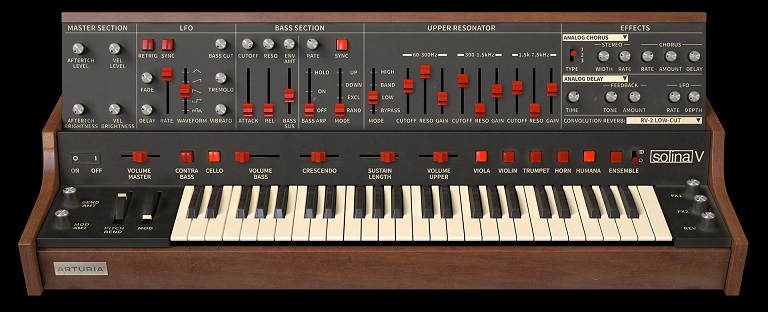
To be continued...
E-Mail Grant








